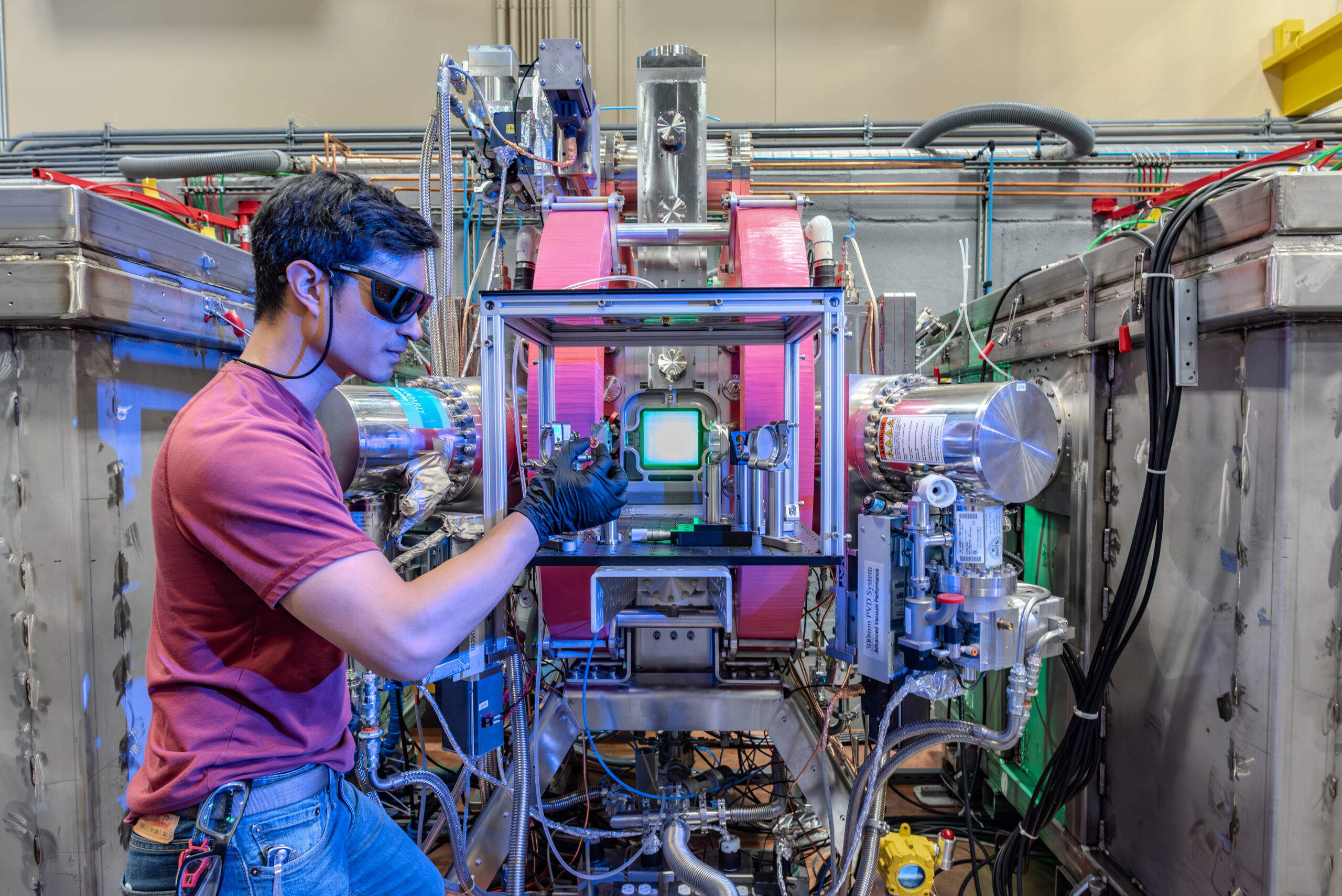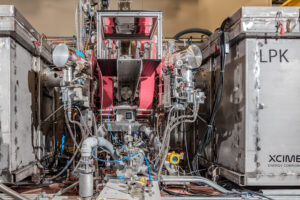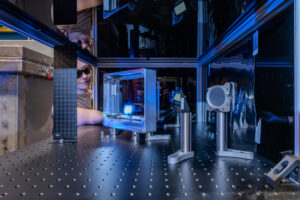Our first laser system is operating and already achieving records

We brought a record-setting laser online – the first step in turning decades of fusion science into commercial hardware.
By Alex Valys
In December 2022, the National Ignition Facility (NIF) at Lawrence Livermore National Laboratory achieved scientific breakeven from fusion for the first time, using laser-driven inertial confinement. In other words, NIF produced more energy from fusion than the laser energy which was used to compress, heat and ignite a small capsule of fusion fuel – a major milestone that marked NIF and laser inertial fusion as the best-performing fusion system of any kind, and the only one experimentally demonstrated to exceed scientific breakeven.
This was a groundbreaking moment for fusion. But NIF was never meant to scale to commercial power generation, and the laser technology used on NIF would be incredibly costly to use for a power plant. Our goal at Xcimer is to take the plasma physics and fusion confinement concept successfully demonstrated on NIF, and couple it with a lower-cost, higher-energy laser system that can scale to commercial application.
And because NIF has already derisked the science, we’ve been able to move quickly into the execution of our commercial plan and the engineering of this laser architecture, as opposed to proving the basic viability of the confinement approach like many other concepts still must do.
Today, we’re sharing a major milestone in our execution and progress along this path – the completion of our Long Pulse Kinetics Platform (LPK), the world’s first electron-beam-pumped excimer laser built in the private sector, and the first such KrF laser built anywhere in the world in the past 20 years.
These kinds of lasers were invented in the United States in the 1970s, originally for defense applications, and have long been studied for inertial fusion. But this prior work happened in US DOE labs, academia, and DOD contractor facilities, much of it outside of public view. Most recently, the U.S. Naval Research Laboratory (NRL) did pioneering work advancing the science and engineering of excimer lasers for fusion energy applications with the Nike and Electra systems in the 1990s and early 2000s. Institutions like NRL and the national labs will continue to have a critical role to play in the future of commercial fusion – while the completion and operation of the LPK marks a major milestone in the transition of laser fusion, and high-energy excimers in particular, into the private sector after decades of development and direction led by the US government.
Already Setting Records

One of our goals at Xcimer is to achieve cost savings by running krypton fluoride excimer lasers at longer pulse lengths (1-3 microseconds) than previous efforts have focused on (up to 500 nanoseconds). And so a major purpose of the LPK was to build a system that lets us explore the science and engineering needed to operate in this space.
When we submitted our application to the Department of Energy Milestone-Based Fusion Development program, we proposed the completion and operation of the LPK as the first major technical milestone on our path to a pilot plant on the grid.
We’re proud to share that in May, we successfully operated the LPK at a 3 microsecond pulse length, setting a record for the longest pulse in a KrF laser. Operating the LPK testbed has already given us valuable data to benchmark and improve our understanding and modeling of long-pulse e-beam-pumped KrF lasers.
The fact that we built the LPK in four months is a testament to the skill and dedication of the team we’ve built — people who’ve come to Denver from all backgrounds and industries to change history.
The Smallest Laser We’ll Ever Build

We’re proud of the work we’ve achieved in the past year, since we raised our Series A investment. And we’re proud of the records that our laser has already set.
As impressive and exciting as LPK is to us, it’s even more exciting to realize that the LPK is the smallest laser we’ll ever build.
LPK is the first key component of Phoenix, our prototype laser system. It collects the critical data to validate our architecture and guide our full-scale system design. The next laser in Phoenix, which is under construction now, will be over ten times higher energy than LPK.
By 2026, Phoenix will be complete, and prove the operation of all the components of our laser architecture. By 2030, we plan to complete and demonstrate Vulcan, the highest-energy laser facility in the world and the first facility to exceed engineering breakeven from fusion.
To everyone who helped bring LPK to life, thank you. We’re just getting started in our quest to provide clean, virtually limitless electrons on the grid within 10 years.
Inertial fusion: The last energy source humanity needs
Energy has been the fundamental driver of human progress for the past two centuries. We at Xcimer are working on fusion because it’s the only path for humanity to grow our energy usage and continue to progress as a species, as we have since the Industrial Revolution.
At Xcimer, we’re not interested in merely replacing current energy generation with fusion; we’re focused on how to build a technology that will let humanity produce and consume 10x more energy economically, sustainably and safely. Laser fusion, the last new energy source we’ll ever need, will unlock technologies we can’t even conceive of yet and help humanity chart our most prosperous path into the future.
Fusion is in a similar position to the commercial space industry back in 2010. NASA support for SpaceX and other companies shifted risk from government to private industry while catalyzing private investment. That’s why, today, we have a robust and world-leading commercial space industry, for very little taxpayer investment and risk, that is producing enormous benefits to US industry and national security.
Just like space exploration, fusion is moving outside of US national laboratories and government; our Long Pulse Kinetics Platform is the first laser of its kind constructed anywhere, including government labs, in over two decades.
The race is on
Fusion will secure America’s energy autonomy and security for centuries – and in so doing, will enable an era of unprecedented abundance.
But we are not the only ones in the race. In 2023, the Chinese government’s fusion support was $1.5 billion — twice the DOE’s spending. And investments in Chinese fusion companies have risen from zero in 2021 to $1.3 billion in 2024, matching investments in US fusion companies.
The US is far short of fusion spending and for commercialization in particular. Of the Department of Energy’s Fusion Energy Sciences spending from 2020 to 2023, only 1.2% went to fusion commercialization work.
The United States is the cradle of fusion development, the inventor of laser inertial fusion, and the only nation to demonstrate scientific breakeven. We’re racing toward commercialization – and we can’t afford to abandon our lead.
Now is the time for America to accelerate fusion development, and the path is clear: we need to provide similar levels of financial support to the private fusion companies as we provided to private space exploration companies at the turn of the 21st century.